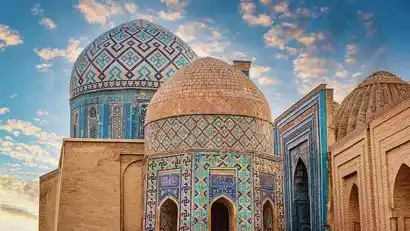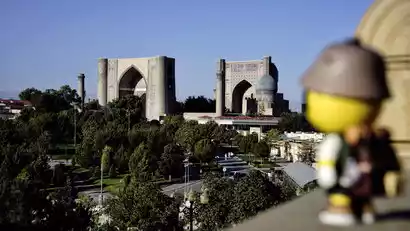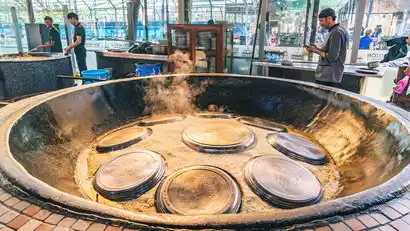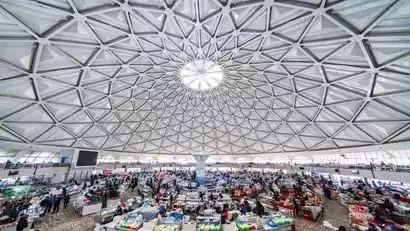Day 1 Almaty ★ Meeting day
All day
Today is the gathering day. Everyone will take their own flights to Almaty, Kazakhstan, and check in at the designated hotel (note: the check-in time for local hotels is generally after 2 p.m., and tourists who arrive early can store their luggage and then have free time).
How to get to Almaty (Almaty International Airport, airport code ALA)
There are many flights to Almaty, including direct or connecting flights from Hangzhou/Beijing/Guangzhou/Xi'an/Urumqi.
Booking in advance will get you discounted fares. If you buy connecting flights, make sure there is a certain amount of time between them: usually more than 3 hours, to avoid missing your flight due to delays.
What to do during free time?
The Central State Museum of Kazakhstan, established in 1985, is one of the largest museums in Central Asia. Spread across three floors, the museum features numerous exhibition halls, including those on paleontology and archaeology. Through its rich collections, visitors can learn about the diverse origins and cultures of the various ethnic groups living in Kazakhstan, as well as the history of Kazakhstan from its declaration of independence in 1991 to the present day.
Central Mosque: One of Kazakhstan's largest and most beautiful mosques, it boasts a 47-meter-tall minaret. Completed in 1999, its dome was originally blue, but was renovated in 2010 to a gold finish. This unassuming mosque is a breath of fresh air.
Arbat G. Almaty is one of Almaty's most famous pedestrian streets, blending culture, art, and the everyday life of the city. The street exudes a relaxed atmosphere and becomes particularly lively in the evenings, with street performers playing guitar and accordion, and young people performing hip-hop dances, creating a rich artistic atmosphere.
Kok Tobe Mountain is an iconic landmark in Almaty, standing 1,100 meters above sea level. It offers panoramic views of the city and the snow-capped mountains in the distance, and the sunset is particularly breathtaking! The summit also boasts a cable car, a Ferris wheel, an amusement park, and a specialty restaurant. You can hike up or take the cable car (reference price: 4,500 tenge per adult one-way, 8,000 tenge per adult round-trip. Please refer to local prices for details).


Day 2 Almaty
·morning
After breakfast at the hotel, we will start our tour of Almaty.
Our first stop was the 28 Panfilov Heroes Memorial Park, dedicated to the Soviet heroes of the 16th Regiment of the 316th Division who died fighting against the Nazis in 1941. Among them were 28 soldiers from Almaty. The park's solemn and majestic sculptures vividly depict the soldiers' fearlessness in the face of the enemy, while the blazing flames of the Eternal Burning Beacon embody their enduring spirit of resistance.
We then walked to the Ascension Cathedral in the park, now Almaty's oldest building. It was the only structure to survive the 1911 Almaty earthquake, largely due to its construction without a single nail. It is the second tallest wooden structure in the world. Inside, the medieval Orthodox murals, crystal chandeliers, and stained glass windows are truly remarkable.
Afterward, we'll visit the Green Bazaar, one of the oldest and most vibrant markets in the region, dating back to the 19th century. It's a great place to immerse yourself in the daily lives of Kazakhs, chat with the friendly locals, and learn about local prices and dining habits. Here, you'll also witness a microcosm of Almaty's culture, where you can still see Kazakhs making sausages from horse meat, Russian women selling pork, and Korean descendants selling kimchi.
·afternoon
In the afternoon we will embark on an exciting light outdoor experience.
Special experience/Electric bicycle riding around the mountains and heading to the Big Almaty Lake
We arranged a special e-bike tour to explore Big Almaty Lake. Without breaking a sweat, we ascended, passing streams, wildflowers, spruce forests, and alpine meadows. We stopped as often as we could, taking in the beautiful scenery along the way. Escape the concrete and concrete world, and let pure nature soothe our souls and eyes. Finally, we arrived at Big Almaty Lake, the "Pearl of the Mountains," at an altitude of 2,511 meters. The lake's color changes with the seasons, from emerald green in summer to a deep blue like a gem in autumn. Surrounded by snow-capped mountains, it resembled a fairyland.
Note: As Big Almaty Lake is one of the main sources of drinking water for Almaty, there is a protected area around the lake and visitors are prohibited from directly contacting the lake water.
After the tour, we cycled back to Bear Canyon for a Kazakh Afternoon Tea. We enjoyed a sip of warm tea with Baursak, Kazakhstan's most representative traditional fried noodle dish, and experienced the culinary wisdom of the nomadic people while taking a short break.
After the break, tourists can move freely in Bear Canyon.
Finally, we headed to the First Presidential Park, named after the country's first president, Nursultan Nazarbayev. It combines political memorials, natural landscapes, and recreational activities. It boasts a fountain complex, known as the "world's most majestic gate," and the largest in Almaty, comprised of bronze sculptures of the twelve zodiac animals. The park is located at the foot of the Tianshan Mountains, offering stunning views of the snow-capped peaks on clear days. It's also a popular spot for locals to enjoy a leisurely stroll, brimming with life.


Day 3 Almaty
·morning
After breakfast at the hotel, we will visit the Folk Culture Village, a unique open-air museum of historical and ethnic culture. Here you can gain an in-depth understanding of the culture and lifestyle of the nomadic peoples of the steppes, including yurts, horseback riding, archery, folk costume dressing, traditional Kazakh cuisine, falconry shows, equestrian performances, and more.
·afternoon
丨Special Arrangement/Lie Flat Plan in the Clouds, Take a Cable Car to Unlock the Same Snow Mountain Meadow as in Switzerland
In the afternoon, we'll first visit Ili-Alatau National Park. We'll arrange a round-trip cable car ride to the summit of Qiongbulak Snow Mountain, at an altitude of 3,000 meters. This three-section cable car ride is sure to delight tourists. Each section offers a unique view, with snow-capped mountains, forests, and villas interwoven, creating a Swiss-style experience.
Afterward, visit the Kasteyev State Art Museum, Kazakhstan's largest art museum, named after Abulkhan Kasteyev, one of the founders of the Kazakh school of painting. The museum's collection boasts over 20,000 works by Kazakh, Russian, and Western European artists, spanning various historical periods and artistic styles. Exhibitions include classic paintings, modern artworks, and decorative and applied art. For art lovers, this is an inspiring place.


Day 4 Almaty → Tashkent (flights to be announced)
·morning
After breakfast at the hotel, transfer to the airport to board your flight to Tashkent, the capital of Uzbekistan.
Tashkent retains a wealth of pre-Soviet architecture and facilities, seemingly frozen in time. It was also a key commercial hub on the ancient Silk Road, where ancient Chinese figures like Zhang Qian, Faxian, and Xuanzang all left their mark.
After arriving and clearing customs, enjoy lunch and rest.
·afternoon
After lunch, we'll first visit the National Museum of Uzbekistan. Experienced and professional guides will unveil Uzbek history and showcase its millennia-old heritage. As the oldest museum in Uzbekistan, its collection spans over 250,000 items, spanning the country's history from the Stone Age to the present day. This will provide a glimpse into Uzbek history and provide a clear understanding of its history, paving the way for your upcoming visit.
Note: The National History Museum of Uzbekistan is under renovation and renovation. If it is still not open, it will be replaced by [Tashkent Museum of Applied Arts], [Kurkhda Madrasah], and [White Mosque].
丨Special Experience/Travel through the Underground Art Palace and Decipher Tashkent's Soviet Aesthetics
Then embark on the Tashkent Metro Experience and become a local for a while, experiencing the local subway station, which is like a small museum. Lonely Planet describes it as one of the most beautiful Soviet-style subway systems in the world.
After getting off the subway, check out Timur Square. It was built to commemorate Timur, a great strategist, military strategist and politician in Uzbek history. In the center of the square is a bronze statue of Timur riding a horse and holding a sword, which looks majestic and domineering.
Today, the tourists are free to explore the city after dinner.


Day 5 Tashkent → Bukhara
·morning
After breakfast at the hotel, we will take the high-speed rail to Bukhara to witness the final glory of the Central Asian Silk Road.
Bukhara is the most sacred city in Central Asia, the starting point of the romantic fairy tale of One Thousand and One Nights, the birthplace of Alibaba's battle with the Forty Thieves, and the starting point of Avanti's battle with Master Bayi. Lonely Planet also praises it highly. It is located on a sacred mountain and has buildings with a history spanning thousands of years.
Lunch upon arrival.
·afternoon
In the afternoon, we first visited the Samanid Tombs. The tomb is said to have been built in 905. It is small in scale but full of characteristics. Such a small building can be found in the textbook of "History of World Architecture" and its name is also on the list of World Cultural Heritage.
Afterward, we'll visit the Grand Bazaar, Bukhara's largest market. Not only is it a popular shopping destination for locals, it's also a perfect place to experience the vibrant atmosphere of Central Asia. A stroll through it feels like stepping back in time to the golden age of the Silk Road's caravans!
We then took a look at the Porokoz Mosque (the interior of the mosque is closed to locals, as it is a place of worship). It's one of Bukhara's most noteworthy buildings. Its uniqueness lies in the 20 massive carved wooden pillars at the entrance. In Uzbekistan, wood is more valuable than stone or brick, and there are 20 of these massive wooden pillars. Despite the erosion of time, the intricate carvings can still be seen.
Around sunset, head to the Yak Castle, Bukhara's most interesting and oldest historical building. It served as the residence of the Bukhara ruler until 1920. It's also the perfect spot to view the Kalon Mosque and the old city of Bukhara, and admire one of Bukhara's most beautiful sunsets under the setting sun.
Everyone still takes care of their own dinner in the evening.
We'll stay directly in a guesthouse within the ancient city of Bukhara, making it convenient for everyone to explore the city freely at night. However, there are relatively few guesthouses in the ancient city that can accommodate large groups, so accommodations are limited. Please understand!


Day 6 Bukhara
·morning
After breakfast at the hotel, stroll through the old city of Bukhara.
Visit the exterior of the Charminar Mosque, featured on the cover of Lonely Planet. Built in 1807, it was the gatehouse of a long-gone seminary. Each minaret in the Charminar has a unique shape, and its decorative elements are believed to reflect the philosophy of the world's four major religions.
Afterwards, visit the Lybīrīhās complex, comprised of the Kukdāhi Madrasah to the north and the Nadir Diwan Begī Madrasah to the east. Built in 1620, the square retains its old-world style. Its most famous feature is the statue of Avanti, the ancestor of Bukhara.
丨Special Arrangement/Meet the Time Craftsmen Deep in the Ancient City
Bukhara is also a hub for skilled artisans, with various craftspeople scattered throughout the old city. We'll visit the Puppet Museum to learn about the story of the founder and his puppets. We'll also admire a variety of handmade puppets, learn about the production process, and watch a lively puppet show. You'll also have the opportunity to personally experience this age-old craft. If you have a discerning eye, you might even spot some familiar puppets!
·afternoon
In the afternoon we went to the Abdulaziz Khan Madrasah, which had hardly been repaired. The tiles inside were severely peeling and it looked very dilapidated, but the reliefs on the arches were magnificent and it was the most beautiful arch among the many Islamic buildings in Bukhara.
Then we went to the Bukhara Ulugh Beg Madrasah, another madrasah left behind by Ulugh Beg the Great during the Timurid Empire. Built at the same time as the Ulugh Beg Madrasah in Samarkand's Registan Square, they share a nearly identical structure, serving as templates for subsequent madrasahs.
Then, we visited the Mir Arab Madrasah, one of the earliest Madrasahs built during the Bukhara Khanate period and a prime example of Islamic architecture. (Please understand that entry is not permitted during religious activities.)
Finally, visit the Kalon Minaret and Mosque, a landmark that even Genghis Khan admired. Dating back to the 15th century, the minaret within the mosque is truly legendary. Completed in 1127, the minaret stands 46.5 meters tall, earning it the title of "Tallest Tower in Central Asia." Untouched by any restoration, the towering structure is constructed from layers of bricks, the beautiful arrangement of which showcases the ancients' extraordinary artistic aesthetic.
Afterward, everyone is free to explore the Dome Bazaar. Located on a strategic Silk Road route, Bukhara boasts a thriving market and flourishing commerce. Traditional markets here, known as Taqi, are dome-shaped marketplaces built at central intersections. Three of these markets remain, each retaining its original appearance. The diverse merchandise on offer includes many uniquely Uzbek goods, including ceramics by skilled artisans, carpets and silk embroidery by women, and exquisite gold jewelry.


Day 7 Bukhara → Samarkand
·morning
In the morning, everyone is free to do what they want, enjoy a breakfast without morning calls, and explore every corner of the ancient city of Bukhara at will.
You can find a teahouse or coffee shop in the ancient city and experience the slow pace of Bukhara; you can also go shopping in the countless hidden gems in the streets and alleys; or just stroll around the ancient city and encounter every unexpected encounter around the corner...
Everyone is on their own for lunch.
·afternoon
In the afternoon, we drove to Samarkand, a city with a history spanning over 2,500 years and a crucial Central Asian hub along the Silk Road. From the ancient kingdom of Kangju to Khwarezm, and then to the capital of the Timurid Empire, Samarkand not only connects east and west, but also north and south, making it a most dazzling hub along the Silk Road.
Upon arrival, enjoy a night tour of the Registan Complex (exterior view). Samarkand's most famous landmark, consisting of three madrasas and a square, is known as the "Heart of Samarkand." As the sunset fades and night falls, the lights of the Registan Square cast an even more magnificent and mysterious light on the magnificent and exquisite Registan Complex.


Day 8 Samarkand
·morning
Today's full day of activities in Samarkand.
After breakfast at the hotel, be sure to take advantage of the early morning to visit the Shah-i-Zinda Mausoleum Complex, where blue tiles create the finest beauty in Central Asia. Shah-i-Zinda, meaning "Eternal King," is one of Samarkand's earliest and most important Islamic mausoleums. Its interwoven patterns of azure, cerulean, and creamy white create a magnificent and romantic atmosphere.
Then visit the Ulugh Beg Observatory, one of the greatest archaeological discoveries of the 20th century, known as "The Stars Above Samarkand." Step inside the observatory and experience the legendary fate of this great man who governed the country while simultaneously delving into astronomy.
Then go to the Afroshaiber Museum, which is the most valuable museum in Samarkand. It displays many cultural relics of Samarkand before Genghis Khan unearthed from the Afroshaiber ruins, as well as many exquisite murals. You will also find many contents from the Tang Dynasty.
·afternoon
In the afternoon, we'll visit the Bibi Haneim Mosque, considered one of the most magnificent buildings in the East during the Timurid era. Its low-saturation, high-quality blue dome and mosaic walls create a striking beauty that belies its age.
Then visit the Gur Amir Mausoleum, the mausoleum of Timur and his descendants, built in the 15th century. The dome is so magnificent that it makes you want to leave even if your neck hurts.
Finally, we came to the Registan Complex again. There are three tall, magnificent and imposing seminary buildings, with a magnificent mosque inside. Walking through the towering arches, there is a hall covered with patterns and a golden dome. The blue glazed tiles on the wall are of different shades, and the patterns are complex but regular. The verses of the Koran are paved with gold, shimmering in the sunlight.
丨Special arrangement/Visit the local tile workshop and personally select your Silk Road memories
Hidden deep within Rekistan Square lies a unique tile workshop. Many of Central Asia's most iconic buildings are adorned with a variety of mosaic tiles, with Samarkand being particularly renowned, particularly for its "Shay-Zindar Blue." After admiring so many mausoleums, madrasas, and mosques, you'll undoubtedly be deeply impressed. Therefore, we'll visit a tile workshop to learn more about the local tile-making process and hear the workshop owner share his deep connection with tile. Best of all, you and your family can choose a beautiful tile as a souvenir!
Afterwards, everyone will explore the local cuisine on their own in the evening.


Day 9 Samarkand → Tashkent ★ Disbandment Day
·morning
After breakfast at the hotel, drive back to Tashkent.
Upon arrival, lunch will be at the Central Asian Pilaf Center, where you'll savor pilaf cooked in the world's largest pot. Pilaf is the national dish of the Uzbeks. There's a saying: "Poor Uzbeks eat pilaf, while wealthy Uzbeks eat it every day."
·afternoon
After a full meal, we took a look at the Tashkent TV Tower, a landmark building in Tashkent that was once the third tallest building in the world.
Then, we'll visit Hazrat Imam Square, the officially recognized Islamic religious center of Uzbekistan. Here, the world-famous Quran of Caliph Osman is preserved, one of only three surviving copies of the Quran in the world. (Note: Entry is not permitted during religious activities.)
Finally, we arrived at Qiongsu Bazar, Tashkent's most famous market and one of the oldest trading areas in Central Asia, with a history spanning centuries. The bazaar offers a glimpse into local life, where you'll find mountains of spices, fresh fruit, amber-colored dried fruits, baked bread, fresh meats, horse sausages, handmade colorful cushions, ceramics, and knives...
After dinner, we will arrange a group transfer to the airport to prepare for the flight back to China. If you still feel unsatisfied, you can stay and explore on your own or start the next journey.
丨Instructions for Dissolution Day
Today is the disbanding day. We recommend that you choose a return flight after 21:00. Please also consult the online customer service or product manager (phone and WeChat ID: 15967118126) for a second confirmation before placing an order.









